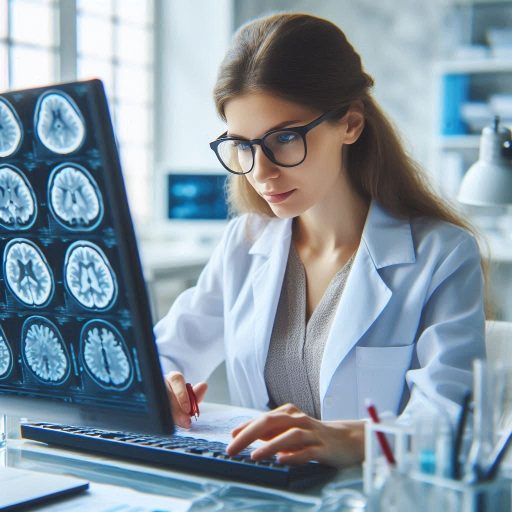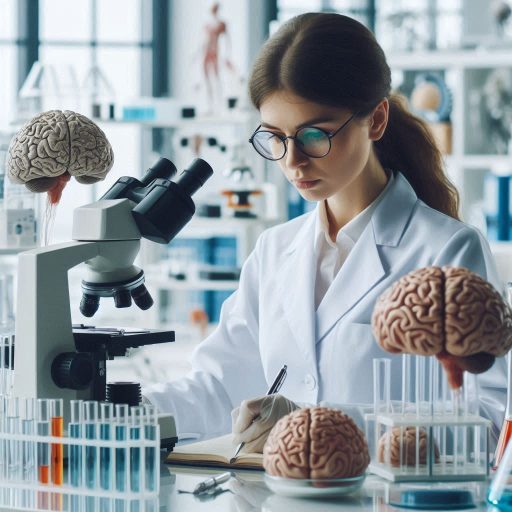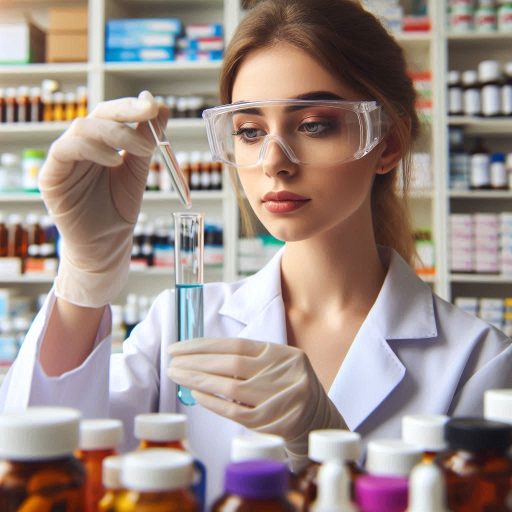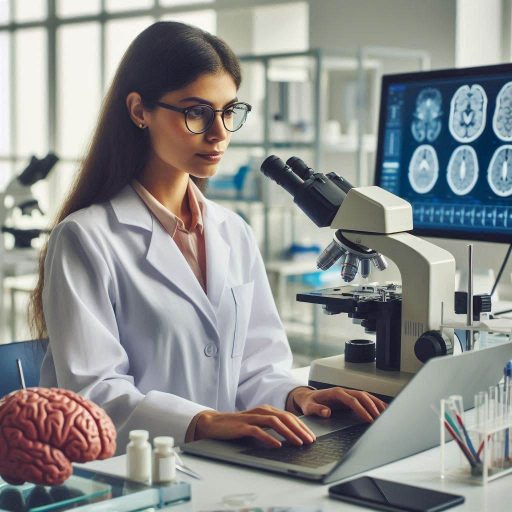Introduction
Pharmacokinetics and pharmacodynamics are crucial concepts in medicine.
Pharmacokinetics studies how the body absorbs, distributes, metabolizes, and excretes drugs.
In contrast, pharmacodynamics examines how drugs affect the body and their mechanisms of action.
Both fields work together to ensure effective and safe medication use.
Understanding these concepts is essential for healthcare professionals.
Knowledge of pharmacokinetics helps determine optimal drug dosages and administration routes.
It also aids in predicting drug interactions and potential side effects.
Meanwhile, pharmacodynamics provides insights into drug efficacy and safety profiles, enabling practitioners to tailor treatments for individual patients.
This blog post will delve deeper into pharmacokinetics and pharmacodynamics.
We will explore key factors affecting drug absorption and distribution.
Next, we will discuss the metabolic pathways that impact drug effectiveness and clearance.
Additionally, we will highlight the significance of receptor interactions in pharmacodynamics.
By the end of this post, readers will gain a comprehensive understanding of these critical concepts.
This knowledge will enhance their ability to make informed decisions in clinical practice.
Ultimately, a solid grasp of pharmacokinetics and pharmacodynamics leads to better patient outcomes and more effective therapeutic strategies.
Join us as we navigate these fascinating topics in the world of medicine.
What is Pharmacokinetics?
Pharmacokinetics is the study of how drugs move through the body.
It examines the processes of absorption, distribution, metabolism, and excretion (ADME), which determine how drugs behave after administration.
Pharmacokinetics provides crucial insights into drug effectiveness, safety, and the timing of doses.
Definition of Pharmacokinetics
Pharmacokinetics refers to the study of the body‘s effect on a drug from the moment it is administered until it is eliminated.
By understanding these processes, healthcare providers can determine the best ways to administer drugs to achieve optimal results.
Process of Absorption, Distribution, Metabolism, and Excretion of Drugs in the Body
The movement of drugs through the body involves four key steps: absorption, distribution, metabolism, and excretion (ADME).
These steps dictate how quickly and efficiently a drug works.
Absorption
Absorption is the process by which a drug enters the bloodstream after being administered.
Depending on the route‘oral, injection, topical‘the speed of absorption can vary.
Orally taken drugs must pass through the digestive system before absorption.
In contrast, injected drugs enter the bloodstream immediately.
Distribution
Once absorbed, the drug is distributed throughout the body via the bloodstream.
This distribution depends on factors such as blood flow, the drug‘s ability to cross cell membranes, and how much of the drug binds to plasma proteins.
Efficient distribution ensures that the drug reaches the target tissues where it can act.
Metabolism
Metabolism is the body‘s process of breaking down drugs, typically in the liver.
Liver enzymes convert the drug into metabolites, which are usually less active forms.
However, some drugs are activated through metabolism.
The rate of metabolism can affect how long a drug remains active in the body.
Excretion
Excretion is the elimination of the drug and its metabolites from the body, usually through the kidneys via urine.
Other excretion routes include bile, feces, sweat, and even breath.
Proper excretion is crucial for preventing drug accumulation and potential toxicity.
Factors That Influence Pharmacokinetics
Several factors can influence the pharmacokinetic processes, including age, gender, and genetics.
These factors can alter how a drug is absorbed, distributed, metabolized, and excreted, making personalized dosing essential for ensuring safe and effective treatment.
Age
As people age, their metabolism and kidney function tend to slow, affecting drug breakdown and excretion.
Older adults may require lower or less frequent doses to prevent drug accumulation.
Gender
Gender differences, such as variations in body fat and hormones, can affect how drugs are metabolized and distributed.
Genetics
Genetic variations can influence enzyme activity and alter how individuals metabolize specific drugs, leading to differences in drug efficacy or risk of side effects.
Understanding these factors helps optimize drug therapy and ensures that treatments are tailored to individual patient needs.
Read: Educational Path: Becoming a Geologist in the USA
Understanding Absorption
Definition of Absorption
Absorption refers to the process by which a drug enters the bloodstream from its site of administration.
For a drug to exert its therapeutic effects, it must first pass through various biological barriers and be absorbed into the bloodstream.
The rate and extent of absorption directly influence how quickly and efficiently a drug reaches its target site.
Different Routes of Drug Administration
The route of drug administration significantly impacts absorption.
There are several common methods of administration, each affecting the speed and efficiency of absorption differently.
- Oral administration is the most widely used route.
After ingestion, the drug passes through the gastrointestinal tract, where it is absorbed into the bloodstream.
Absorption rates vary depending on factors like the presence of food and the drug‘s solubility. - Intravenous (IV) administration involves delivering the drug directly into the bloodstream.
This method bypasses the absorption process entirely, offering immediate effects and 100% bioavailability. - Intramuscular and subcutaneous injections deliver drugs into muscle or fat tissues, from where they are gradually absorbed into the bloodstream.
- Inhalation, topical, and rectal routes provide alternative means of administering drugs, each with its own absorption profile based on the type of tissue involved.
Factors Affecting Drug Absorption
Several factors can influence how well a drug is absorbed.
Understanding these factors is crucial to optimizing drug effectiveness.
- Food: The presence of food in the stomach can either slow down or enhance drug absorption.
Fatty meals, for instance, may delay absorption by slowing gastric emptying, while other types of food may help increase solubility and absorption of certain drugs. - pH Levels: The pH of the gastrointestinal environment can also play a critical role in absorption.
For example, acidic drugs are better absorbed in the stomach, while alkaline drugs are more readily absorbed in the intestines.
pH variations can alter the ionization state of a drug, impacting its ability to pass through cell membranes. - Dosage Form: The formulation of a drug, whether in tablet, capsule, liquid, or extended-release form, can greatly affect absorption.
Liquids and dissolvable forms tend to be absorbed more quickly than tablets or capsules, which require more time to break down. - Surface Area and Blood Flow: The surface area of the absorption site, such as the small intestine, and the blood flow to that area also determine how efficiently a drug is absorbed.
More blood flow allows for faster absorption, while greater surface area increases the drug’s exposure to absorption mechanisms.
Healthcare professionals can optimize drug dosing by understanding key factors that affect absorption.
They must also consider the choice of administration route to ensure maximum therapeutic benefit.
optimize drug therapy for better patient outcomes.
Read: Botany Career Fairs and Networking Events
Drug Distribution in the Body
Definition of Drug Distribution
Drug distribution refers to the process by which a drug moves from the bloodstream into different tissues and organs.
Once a drug enters the circulatory system, it travels through the blood and begins to spread throughout the body.
This distribution is essential for the drug to reach its target areas and produce the intended therapeutic effects.
Transform Your Career Today
Unlock a personalized career strategy that drives real results. Get tailored advice and a roadmap designed just for you.
Start NowHow Drugs Are Distributed in Different Tissues and Organs
After a drug enters the bloodstream, it can either stay in the blood plasma or move into tissues through capillary walls.
Organs like the liver, brain, heart, and kidneys typically receive drugs faster due to high blood flow.
This allows for rapid therapeutic action in these organs.
Conversely, muscles, fat, and bones have lower blood flow, meaning drugs take longer to reach these areas.
As a result, drugs may accumulate in these tissues over time, leading to a slower release of the drug.
Factors Influencing Drug Distribution
Blood Flow
Blood flow plays a major role in how quickly a drug reaches different tissues.
Organs with higher blood flow, such as the liver, heart, and brain, receive drugs more rapidly.
These areas often exhibit faster therapeutic responses as a result.
In contrast, areas like adipose tissue or bone, which have lower blood flow, receive drugs more slowly.
This delay can prolong the drug‘s presence in the body.
Protein Binding
Once in the bloodstream, some drugs bind to plasma proteins like albumin.
Only the unbound (free) drug can cross capillary walls and enter tissues.
Drugs with a higher protein-binding capacity tend to distribute more slowly, as the bound portion remains inactive in the bloodstream.
This binding acts as a reservoir, slowly releasing the active drug as the unbound portion is used up.
Lipid Solubility and Tissue Permeability
The ability of a drug to enter tissues also depends on its lipid solubility.
Lipid-soluble drugs can easily cross cell membranes, enabling them to move into fatty tissues.
Water-soluble drugs, however, may struggle to penetrate certain barriers like the blood-brain barrier.
These differences affect where the drug can accumulate and how quickly it can reach its target.
Tissue Binding
Some drugs bind tightly to tissue proteins, causing them to accumulate in specific organs.
This accumulation can affect the drug‘s distribution and potentially lead to toxicity if high concentrations are reached in certain tissues, such as the liver or kidneys.
Understanding how drugs distribute and the factors that influence this process helps healthcare professionals optimize drug dosing.
This knowledge allows them to create effective treatment plans for better therapeutic outcomes.
Read: Preparing for a Botany PhD: Tips and Advice
Metabolism of Drugs
Definition of Drug Metabolism
Drug metabolism refers to the biochemical processes by which the body alters the structure of drugs.
This process typically transforms lipophilic compounds into more water-soluble substances, facilitating their elimination.
Metabolism is crucial because it affects how long a drug stays active in the body and its overall effectiveness.
Without proper metabolism, drugs can accumulate, leading to toxic effects or reduced therapeutic benefits.
The liver is the primary organ responsible for drug metabolism, but other tissues, including the kidneys and intestines, also contribute.
Role of Enzymes in Drug Metabolism
Enzymes play a central role in drug metabolism, as they catalyze the chemical reactions that break down drugs.
The cytochrome P450 (CYP) enzyme family is the most important group involved in metabolizing drugs.
These enzymes, found mainly in the liver, help modify the drug’s chemical structure, making it easier for the body to eliminate.
The activity of these enzymes can vary significantly between individuals due to genetic factors, which can impact the drug’s effectiveness and safety.
In some cases, enzyme activity is enhanced or inhibited by other drugs, leading to drug interactions.
Types of Drug Metabolism: Phase I and Phase II Reactions
Drug metabolism occurs in two phases: Phase I and Phase II reactions.
Phase I Reactions
Phase I reactions involve the introduction or exposure of functional groups on the drug molecule.
These reactions include oxidation, reduction, and hydrolysis, and are primarily carried out by the CYP enzymes.
During these reactions, the drug is chemically altered, often resulting in the creation of a more polar metabolite.
In some cases, Phase I reactions can activate a prodrug, converting it into its active form.
Alternatively, these reactions may inactivate the drug, preparing it for excretion.
Phase II Reactions
Phase II reactions involve conjugation, where the drug or its Phase I metabolite is coupled with an endogenous substance.
Common conjugating agents include glucuronic acid, sulfate, and glutathione.
These reactions further increase the water solubility of the drug, facilitating its elimination via urine or bile.
While Phase II reactions generally follow Phase I, some drugs can bypass Phase I and undergo direct Phase II metabolism.
These conjugation reactions play a vital role in detoxifying drugs and making them easier to remove from the body.
In essence, drug metabolism is essential for converting drugs into forms the body can efficiently eliminate.
Enzymes, particularly the CYP family, drive this process, ensuring that drugs are broken down into less active, more water-soluble forms.
Understanding the differences between Phase I and Phase II reactions clarifies how the body processes and eliminates drugs.
This knowledge impacts both the therapeutic effects and potential toxicity of medications.
Read: Interdisciplinary Research: Botany and Other Sciences

Excretion of Drugs
Definition of Drug Excretion
Drug excretion refers to the process by which the body eliminates drugs or their metabolites.
This crucial step ensures that drugs do not accumulate to toxic levels, maintaining balance and promoting health.
Most drugs undergo metabolism before excretion, but some may be excreted unchanged.
The process involves several organs, each playing a key role in clearing drugs from the system.
Organs Involved in Drug Excretion
The primary organ responsible for drug excretion is the kidneys.
The kidneys filter drugs and their metabolites from the blood into urine, where they are expelled from the body.
For drugs that are not filtered out efficiently by the kidneys, the liver becomes important.
The liver processes drugs through bile secretion, releasing them into the intestines, from where they can be eliminated through feces.
Some drugs, especially those that are volatile or gaseous, are excreted through the lungs.
For instance, anesthetic gases are largely eliminated via exhalation.
The skin, though less prominent, also plays a minor role in drug excretion through sweat.
Each of these organs contributes to a comprehensive drug clearance system.
Factors Affecting Drug Excretion
Several factors influence how efficiently a drug is excreted, with renal function being one of the most significant.
When the kidneys are not functioning properly, drug clearance is reduced, potentially leading to drug accumulation and toxicity.
Patients with chronic kidney disease, for instance, often require adjusted drug dosages to prevent adverse effects.
Similarly, age impacts excretion, as kidney function tends to decline in older adults.
This slower excretion rate means older individuals may experience prolonged drug action, increasing the risk of side effects.
What is Pharmacodynamics?
Definition of Pharmacodynamics
Pharmacodynamics refers to the study of how drugs affect the body.
It explores the mechanisms by which medications produce their effects.
This field provides crucial insights into both therapeutic and adverse actions of drugs.
By understanding pharmacodynamics, healthcare professionals can make informed decisions about dosing and treatment plans.
Study of Drug Effects on the Body and Mechanisms of Action
Pharmacodynamics examines how a drug interacts with cellular targets, receptors, or enzymes to elicit specific responses.
These interactions are essential for understanding how medications work.
For instance, drugs may bind to receptors on cell surfaces or inhibit enzymes involved in physiological processes.
By studying these mechanisms of action, clinicians can tailor treatments to meet individual patient needs.
The primary goal of pharmacodynamics is to identify the minimum concentration needed to produce a therapeutic effect.
Additionally, it determines the concentration that can lead to toxicity.
This information helps establish the therapeutic window, which is the range in which a drug is effective but not harmful.
For example, drugs like antibiotics have a specific therapeutic range that ensures efficacy while reducing the risk of resistance.
Relationship Between Drug Concentration and Response in the Body
Pharmacodynamics explores the dose-response relationship, which describes how the body responds to varying concentrations of a drug.
At low concentrations, the drug may produce minimal effects.
In contrast, higher concentrations often lead to more significant responses.
However, there is a ceiling effect, where further increases in drug concentration do not enhance its effect.
This phenomenon helps explain why certain dosages are more effective and why higher doses may increase the risk of side effects.
Another critical aspect of pharmacodynamics is drug potency.
Potency refers to the amount of drug required to produce a specific effect.
A drug with high potency requires only a small dose to achieve its desired effect.
Conversely, a drug with low potency requires a larger dose.
Understanding drug potency helps clinicians choose the right medication and dosage for patients, ensuring efficacy while minimizing risks.
In general, pharmacodynamics is the science of how drugs interact with the body to produce therapeutic or adverse effects.
By studying the relationship between drug concentration, receptor binding, and response, healthcare professionals can optimize drug use.
This understanding improves patient outcomes while minimizing side effects.
Understanding pharmacodynamics is crucial for safe and effective medication management.
Drug Receptors and Mechanisms of Action
Explanation of Drug Receptors
Drug receptors are specialized proteins on the surface or inside of cells that bind to specific molecules.
When a drug interacts with these receptors, it can trigger a range of biological responses.
This binding often initiates a chain of events within the cell, leading to the desired therapeutic effects.
Receptors act as the communication link between a drug and the body‘s biological systems.
Understanding how drugs interact with these receptors is essential for developing effective treatments with minimal side effects.
Different Types of Drug Receptors
There are various types of drug receptors, but the two most common are agonists and antagonists.
Agonists are drugs that bind to a receptor and activate it, mimicking the action of a naturally occurring substance.
By stimulating these receptors, agonists produce a biological response that can lead to therapeutic effects.
An example of an agonist is morphine, which binds to opioid receptors to relieve pain.
Antagonists, on the other hand, bind to receptors but do not activate them.
Instead, they block or dampen the action of agonists or naturally occurring substances.
This prevents the receptor from triggering its usual response.
For example, antihistamines are antagonists that block histamine receptors, reducing allergy symptoms.
Transform Your Career Today
Unlock a personalized career strategy that drives real results. Get tailored advice and a roadmap designed just for you.
Start NowHow Drugs Interact with Receptors to Produce Therapeutic Effects
The interaction between drugs and receptors is crucial for their therapeutic effects.
When a drug binds to a receptor, it can either activate the receptor (as in the case of agonists) or block it (as with antagonists).
The strength and duration of this interaction depend on the drug‘s affinity for the receptor, which determines how tightly the drug binds.
A drug with high affinity will bind more strongly and produce a more potent effect.
In addition to affinity, the efficacy of a drug is important.
Efficacy refers to the drug’s ability to produce a maximum biological response once it has bound to the receptor.
Some drugs may bind tightly but produce only a partial response, while others can fully activate the receptor.
Drugs can also interact with different receptor subtypes, which may lead to varying effects depending on the tissues involved.
For instance, a drug may act as an agonist in one tissue but as an antagonist in another.
This selective interaction allows for more targeted treatments with fewer side effects.
Overall, the relationship between drugs and receptors is fundamental to understanding pharmacology.
By modulating these interactions, healthcare professionals can design treatments that maximize therapeutic benefits while minimizing risks.
Understanding how different drugs act on various receptors provides insight into developing safer and more effective medications.
Explore Further: How to Write a Soil Science Research Proposal
Discover More: Balancing Research and Data Science Projects
Importance of Understanding Pharmacokinetics and Pharmacodynamics
Understanding pharmacokinetics and pharmacodynamics is crucial in modern medicine.
These fields explore how drugs act in the body and how the body affects drugs.
By comprehending these principles, healthcare providers can make informed decisions about drug therapy.
This knowledge leads to better patient outcomes and enhances the effectiveness of treatment.
Advantages of Personalized Medicine Based on Individual Pharmacokinetics
One significant advantage of understanding pharmacokinetics is its role in personalized medicine.
Personalized medicine tailors treatments based on individual patient characteristics.
Factors such as age, weight, genetic makeup, and health conditions can influence drug response.
By studying pharmacokinetics, healthcare professionals can identify the right dosage for each patient.
This approach minimizes the risk of adverse effects and maximizes therapeutic benefits.
Personalized medicine is particularly important for drugs with narrow therapeutic indices, where small dose changes can lead to toxicity or ineffectiveness.
Significance of Optimizing Drug Doses for Better Therapeutic Outcomes
Optimizing drug doses based on pharmacokinetics is essential for achieving better therapeutic outcomes.
Different patients metabolize and eliminate drugs at different rates.
For example, some individuals may metabolize a medication too quickly, rendering it ineffective.
Others may metabolize it too slowly, resulting in toxicity.
Understanding these variations allows healthcare providers to adjust dosages accordingly.
This leads to more precise and effective treatment strategies.
Consequently, patients receive the optimal dose that balances efficacy and safety.
How Understanding These Concepts Can Lead to Safer and More Effective Drug Therapy
Pharmacodynamics plays a crucial role in drug therapy as well.
It examines the effects of drugs on the body, including their mechanisms of action.
Understanding these interactions helps healthcare professionals predict how a patient will respond to a specific medication.
This knowledge can inform the choice of therapy and guide clinicians in monitoring treatment progress.
By understanding pharmacodynamics, healthcare providers can select drugs that are more likely to produce the desired therapeutic effect.
Moreover, comprehending pharmacokinetics and pharmacodynamics enhances patient safety.
A deeper understanding of how drugs work and are processed can prevent medication errors.
Healthcare providers can identify potential drug interactions, side effects, and contraindications more effectively.
This proactive approach reduces the likelihood of adverse events, leading to safer drug therapies.
In a nutshell, understanding pharmacokinetics and pharmacodynamics is essential in the field of medicine.
This knowledge enables personalized medicine, optimizing drug doses for better therapeutic outcomes.
It also enhances patient safety and minimizes adverse drug reactions.
By applying these principles, healthcare providers can deliver safer and more effective drug therapies.
Ultimately, this leads to improved health outcomes for patients.
As medicine continues to evolve, the importance of these concepts will only grow, making them integral to future healthcare practices.
Conclusion
In this blog post, we explored key aspects of pharmacokinetics and pharmacodynamics.
Pharmacokinetics focuses on drug absorption, distribution, metabolism, and excretion.
Understanding these processes helps clinicians determine the right drug dosage for patients.
On the other hand, pharmacodynamics examines how drugs affect the body.
It allows healthcare professionals to predict drug responses and potential side effects.
Recognizing the interplay between pharmacokinetics and pharmacodynamics is crucial in clinical practice.
A strong grasp of these concepts enhances medication management.
It also aids in minimizing adverse effects and optimizing therapeutic outcomes.
When healthcare professionals understand these principles, they can make informed decisions about patient care.
Continuous education in pharmacokinetics and pharmacodynamics is vital for all healthcare professionals.
Staying updated on these concepts fosters improved clinical judgment.
It enables professionals to tailor treatments to individual patient needs effectively.
Moreover, advancements in pharmacotherapy require ongoing learning to keep pace with new drug developments.
Ultimately, a deep understanding of pharmacokinetics and pharmacodynamics enhances patient safety and therapeutic effectiveness.
We encourage all healthcare professionals to seek additional resources and training.
By doing so, they can contribute to better patient outcomes and elevate the standard of care.
Remember, informed decisions lead to healthier patients and more successful treatment plans.




